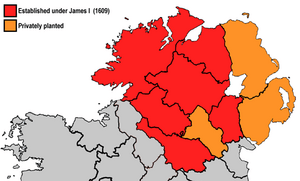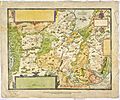Plantation of Ulster facts for kids
The Plantation of Ulster was a time when the English government sent people from Scotland and England to live in Ulster, a province in Ireland. This started around 1606. The main reason was to stop the Irish people in Ulster from fighting against English rule. Ulster had been the hardest region for England to control.
During this time, all the land owned by Irish leaders, called chieftains, from the O'Neill dynasty and O'Donnell dynasty was taken away. This land was then given to the new settlers, also known as colonists. About 500,000 acres (2,000 km²) of land in counties like County Donegal (then called Tyrconnell), Tyrone, Fermanagh, Cavan, Coleraine (now part of County Londonderry), and Armagh were used for the Plantation. Most of Antrim and Down were settled by private groups.
The new settlers were often called "British tenants." They mostly came from Scotland and England. They had to speak English and be Protestant. The Scottish settlers were mainly Presbyterian, while the English settlers usually belonged to the Church of England. The Plantation of Ulster was the largest of all the Plantations of Ireland (other settlements in Ireland).
Why the Plantation Happened
Irish leaders like Hugh O’Donnell and Hugh O’Neill felt that their power and Ulster's independence were in danger from the English. This led to many battles against small English groups, known as the Nine Years' War. They even asked King Philip II of Spain for help. Spanish aid arrived in Kinsale in October 1601, far from Ulster. O’Neill and O’Donnell brought their army to Kinsale on Christmas Eve 1601. However, they were defeated by a strong English army of 20,000 men, led by Lord Deputy Mountjoy.
The Spanish soldiers surrendered. Within two years, O’Neill and other Irish leaders also gave up, signing the Treaty of Mellifont. In this treaty, the Ulster chieftains agreed to accept English rule in their lands. They also agreed to stop using traditional Irish laws (Brehon Law), stop speaking the Irish language, and not plan any more rebellions. With less support from their people and more English control, O’Neill and about one hundred other important Irish families from Ulster left Ireland. This event is known as the Flight of the Earls. They went to places like Spain, Italy, and Rome.
How the Plantation Worked
King James I of England was easily convinced by his officials in Ireland that the best way to make sure Ulster would be loyal to England was through a plantation. First, the areas of Antrim and Down were given to two Scottish noblemen. This brought thousands of Scottish settlers to work on the land. By 1609, these settlers were well established.
The main area for the Plantation covered six counties: Donegal, Derry, Armagh, Fermanagh, Cavan, and Tyrone. The English had learned from earlier plantations. This time, no one was allowed to be given more than 2,000 acres of land, and the rules were stricter. Different groups of people were involved in the Ulster Plantation:
- Undertakers: These were settlers who "undertook" to bring in English or Scottish tenants. Their land was usually 1,000 acres. They paid very low yearly rent, about £5.33. All the undertakers' lands were close together for protection. They promised to build a strong house or a stone wall (called a bawn) around their property. They also had to make sure only English or Scottish tenants lived on their land within three years.
- Servitors: These were people who had worked for the English crown as officials or soldiers during the Nine Years' War. They were the largest group of settlers. They were allowed to have some Irish tenants, but they had to control them strictly. Servitors paid a higher yearly rent of £8.
- Native Irish: This group included Irish people who had stayed loyal to the English during the Nine Years' War. They were given land near the servitors, who were supposed to keep an eye on them.
Images for kids
See also
 In Spanish: Colonización del Úlster para niños
In Spanish: Colonización del Úlster para niños







